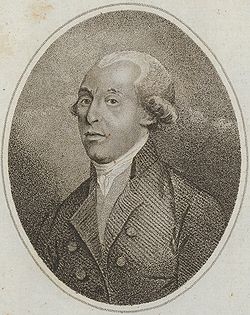Tiberius Cavallo
- Tiberius Cavallo
-
 Pour les articles homonymes
Pour les articles homonymes,
voir Cavallo.
Tiberius Cavallo (né le 30 mars 1749 à Naples et mort le 21 décembre 1809 à Londres) est un physicien italien de la fin du XVIIIe et du début du XIXe siècle.
Biographie
Cette section est vide,
insuffisamment détaillée ou incomplète.
Votre aide est la bienvenue !
Tiberius Cavallo a inventé le micromètre qui porte son nom, un électromètre, un directeur pour diriger, le fluide électrique. Tiberius Cavallo est devenu membre de la Royal Society le 9 décembre 1779
Œuvres
Il a publié :
- un Traité complet d'électricité (trad. par l'abbé Augustin-François de Silvestre, Paris, 1785).
On a encore de lui :
- Essai sur la théorie et la pratique de l'électricité médicale, 1780
- Traité sur la nature et les propriétés de l'air, 1781
- Traité sur le magnétisme, 1787.
Publications en anglais
- A Complete Treatise on Electricity (1777)
- Treatise on the Nature and Properties of Air and other permanently Elastic Fluids (1781)
- History and Practice of Aerostation (1785)
- Treatise on Magnetism (1787)
- Elements of Natural and Experimental Philosophy (1803)
- Theory and Practice of Medical Electricity (1780)
- Medical Properties of Factitious Air (1798).
Sources
Marie-Nicolas Bouillet et Alexis Chassang (dir.), « Tiberius Cavallo » dans Dictionnaire universel d’histoire et de géographie, 1878 (Wikisource)
Catégories : - Naissance à Naples
- Personnalité italienne du XVIIIe siècle
- Personnalité italienne du XIXe siècle
- Physicien italien
- Membre de la Royal Society
- Naissance en 1749
- Décès en 1809
Wikimedia Foundation.
2010.
Contenu soumis à la licence CC-BY-SA. Source : Article Tiberius Cavallo de Wikipédia en français (auteurs)
Regardez d'autres dictionnaires:
Tiberius Cavallo — Nacimiento 30 de marzo de 1749 Nápoles … Wikipedia Español
Tiberius Cavallo — (* 30. März 1749 in Neapel; † 21. Dezember 1809 in London) war ein italienischer Physiker und Naturphilosoph.[1][2] Tiberius Cavallo … Deutsch Wikipedia
Tiberius Cavallo — (also Tiberio) bdd|30|March|1749|21|December|1809 was a Anglo Italian physicist and natural philosopher.LifeHe was born at Naples, where his father was a physician. In 1771 he came to England with the intention of pursuing a mercantile career,… … Wikipedia
Cavallo — ist italienisch und bedeutet Pferd. Der Name Cavallo steht für: ein Fahrrad der Firma Hercules, siehe Cavallo (Fahrrad) ein Reitmagazin, siehe Cavallo (Zeitschrift) eine Produktionsfirma für Reitstiefel und andere Reitbekleidung und zubehör siehe … Deutsch Wikipedia
Cavallo — is a surname, and may refer to: * Domingo Cavallo (born 1946), Argentine economist and politician * Émile Gustave Cavallo Péduzzi, French painter * Jimmy Cavallo (born 1927), American musician * Ricardo Cavallo, Argentine political activist * Rob … Wikipedia
Cavallo — Cette page d’homonymie répertorie les différents sujets et articles partageant un même nom. Personnalités Tiberius Cavallo (1749–1809), physicien italien ; Domingo Cavallo (né en 1946), économiste et homme politique argentin. Rob… … Wikipédia en Français
Cavallo [3] — Cavallo, Tiberius, geb. 1749 in Neapel, war Anfangs zum Hamdel bestimmt, ging 1771 nach London, verließ hier aber den Kaufmannsstand, widmete sich bes. der Physik u. st. 1809 in London; er ist Erfinder des Regenelektrometers u. schr.: Treatise on … Pierer's Universal-Lexikon
Abraham Bennet — (* 1749; † 5. Mai 1799 in Wirksworth, Derbyshire) war ein englischer Pfarrer, Erfinder und Mitglied der Royal Society. Seine Eltern waren der Schulmeister in Whaley Lane, Cheshire Abraham Bennet und Ann, geb. Fallowes. Getauft wurde er am 20.… … Deutsch Wikipedia
Alessandro Volta — For the concept car, see Toyota Alessandro Volta. Alessandro Volta Alessandro Giuseppe Antonio Anastasio Gerolamo Umberto Volta Born … Wikipedia
Abraham Bennet — FRS (baptised 20 December 1749 buried 9 May 1799) was an English clergyman and physicist, the inventor of the gold leaf electroscope and developer of an improved magnetometer. Though he was cited by Alessandro Volta as a key influence on his own… … Wikipedia

